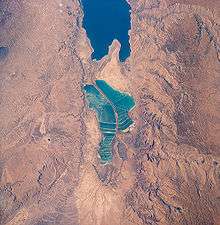Evaporation pond
Evaporation ponds are artificial ponds with very large surface areas that are designed to efficiently evaporate water by sunlight and exposure to the ambient temperatures.

Uses
Evaporation ponds have several uses. Salt evaporation ponds produce salt from seawater. They are also used to dispose of brine from desalination plants. Mines use ponds to separate ore from water. Evaporation ponds at contaminated sites remove the water from hazardous waste, which greatly reduces its weight and volume and allows the waste to be more easily transported, treated and stored.
Evaporation ponds can also be used to evaporate the precipitation that falls on a contaminated site. The contaminants that the water picks up on the ground are left behind after it evaporates. This prevents the contamination from spreading further down the watershed.
Evaporation ponds are used to prevent pesticides, fertilizers and salts from agricultural wastewater from contaminating the water bodies they would flow into. In California, selenium in agricultural wastewater has been especially problematic, causing birth defects in waterfowl.
See also
References
- California Department of Water Resources - Evaporation Ponds
- University of Wyoming - Design Information for Evaporation Ponds in Wyoming
- USDA - Turning Evaporation Ponds into Arable Land
- World Bank - AgWater Sourcebook